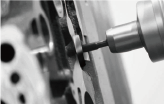
On March 2, 2018, the original Ministry of environmental protection issued the latest national standard "emission standard of air pollutants in foundry industry (Draft for comments)" (GBS [2018] No. 10) (hereinafter referred to as the new national standard). At present, the consultation period of the standard has been completed and will be officially released and implemented in the future. , which is the first national pollution discharge standard specially for foundry industry in China. It is believed that the implementation of the new national standard will have a significant impact on the environmental protection of China's foundry industry. What are the new changes in this standard compared with the past? What are the new requirements for the environmental protection work of the foundry industry? Let's get to know.
1、 What are the requirements of the new national standard?
The new national standard mainly specifies the emission limits, monitoring and supervision and management requirements of air pollutants in foundry industry, and is applicable to the emission management of air pollutants from existing independent casting enterprises and enterprises with casting processes. In addition, the new national standard specially points out that the blast furnace for iron liquid smelting in short process of casting shall comply with the emission standard of air pollutants in iron making industry (GB 28663).
The new national standard mainly includes the regulations on emission limits of air pollution (organized emission), unorganized emission, plant boundary and surrounding pollution control requirements, and air pollution monitoring requirements.
2、 How does the new national standard classify foundry enterprises and Foundry Department?
The new national standard divides casting enterprises into two categories: general enterprises and key enterprises, and different standards are implemented respectively. Among them, the enterprises in key areas implement the standard of "special emission standard", which is more strict than that of general enterprises. The new national standard does not give the definition of "enterprises in key areas", but the regional scope and time for implementing the special emission limits of air pollutants shall be stipulated by the competent department of environmental protection under the State Council or the people's government at the provincial level.
The new national standard divides casting production into metal smelting, molding, core making, casting cooling, old sand regeneration, sand falling, cleaning, post casting heat treatment, surface coating and other departments respectively stipulated emission limits.
3、 What emission indicators are required by the new national standard?
The emission indexes stipulated in the new national standard include five items: particulate matter, sulfur dioxide, nitrogen oxide, VOCs, lead and its compounds.
Particulate matter: it is generally referred to as dust, smoke, fly ash, etc. the actual measurement is the suspended particles with diameter less than 100 μ M.
Sulfur dioxide (SO2): it is the product of burning coal, gas or fuel oil containing sulfide fuel. It can form acid rain after entering the atmosphere, so it is one of the pollutants under control.
NOx: it is a product of combustion of nitrogen containing substances. It can not only form acid rain after entering the atmosphere, but also may participate in the formation of various "toxic gases" through complex redox reactions. Nitrogen and sulfur oxides are mainly from fossil fuels such as coal. Now most enterprises use clean natural gas as fuel, which are relatively low in content; those using electric furnaces are lower.
VOCs (volatile organic compounds): generally refers to the organic matter which is gaseous (with low boiling point) at room temperature and atmospheric pressure. It may participate in atmospheric photochemical reaction, and there are many kinds of VOCs. In this standard, non methane total hydrocarbon (NMHC) is used as the integrated control project for VOCs emissions. NMHC actually measures the sum of hydrocarbons (in carbon) other than methane, of which the main c2-c8 is.
Lead and its compounds: that is, metal lead and lead containing compounds (such as lead oxide, etc.). Lead is a kind of heavy metal element which has high toxicity to human body, so it needs to be strictly controlled. The requirements of this standard are limited to smelting (chemical) lead-bearing non-ferrous gas furnaces
4、 How does the new national standard stipulate the emission limit?
The new national standard gives the general limit and special limit value for the above five indexes, and the specific values are as follows.
5、 When will the new national standard be implemented?
The time limit stipulated in the new national standard is: the new enterprise shall be controlled in accordance with the provisions of this standard since January 1, 2019 and the existing enterprise starts on July 1st, 2020.
This means that, from July 1, 2020, the air pollution emitted by foundry enterprises cannot be implemented in accordance with the relevant provisions of the old national standards "emission standards for industrial furnace and kiln air pollutants" (GB 9078-1996) and "comprehensive emission standards of air pollutants" (GB 16297-1996). For the existing foundry enterprises, if the operation is started immediately, there are still two years to adjust and transform.
However, the new national standard also gives local authorities to execute the national standards strictly
"Local governments may also approve the implementation of this standard in advance according to the local environmental protection needs and economic and technical conditions."
"For projects not specified in this standard, local provincial people's governments may formulate local pollutant discharge standards; for projects already specified in this standard, local pollutant discharge standards that are stricter than this standard may be formulated."
It is still unknown how to implement the specific local standards, but it can be predicted that in some provinces with strict air pollution control, the new national standards will be implemented faster or the local standards stricter than the new ones will be implemented. However, the time for the enterprises to upgrade the proposal is less, generally less than two years.
Foundry enterprises, or as soon as possible to act!



